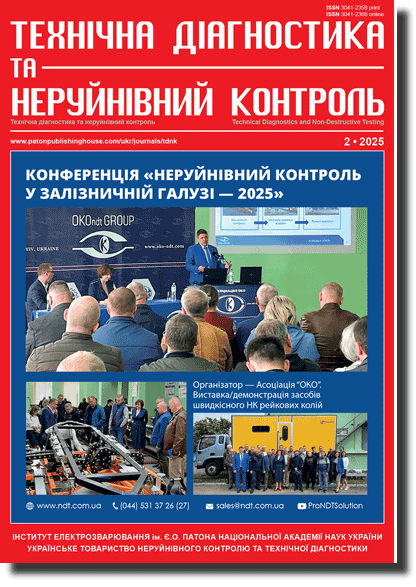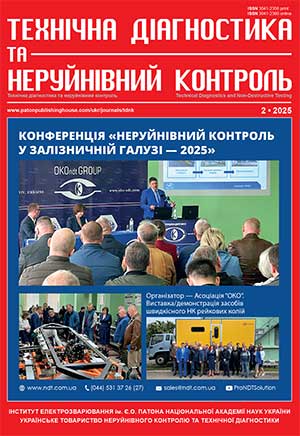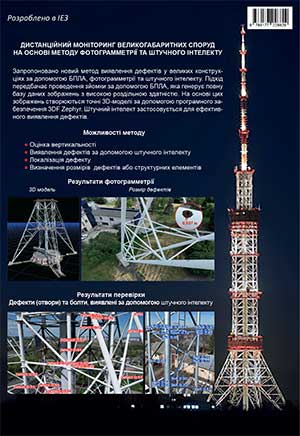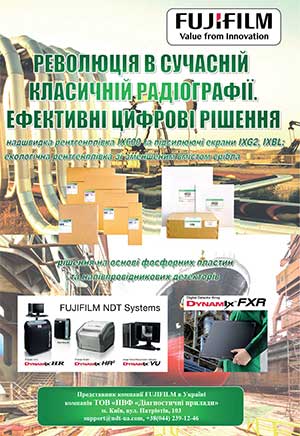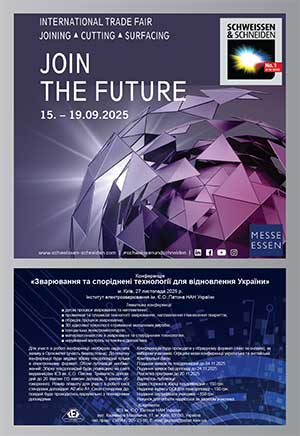| 2025 №02 (02) |
DOI of Article 10.37434/tdnk2025.02.03 |
2025 №02 (04) |
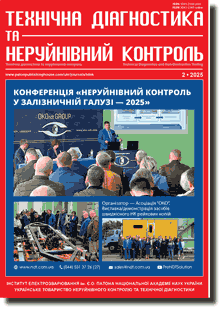
"Tekhnichna Diahnostyka ta Neruinivnyi Kontrol" (Technical Diagnostics and Non-Destructive Testing) #2, 2025, pp. 18-22
Application of wavelet analysis and differential-integral graphical methods for thermograms processing in thermal nondestructive testing
V.O. Storozhenko, O.V. Miahkyi, S.M. Meshkov, R.P. Orel
RTC «Thermocontrol» of Kharkiv National University of Radio Electronics. 14 Nauky Ave., 61166, Kharkiv, Ukraine. E-mail: roman.orel@nure.uaThe problem of increasing the informativeness and reliability of the results of non-destructive testing of high-tech objects of complex structures by the active thermal method is considered. To solve this, we suggest combining the developed integral-differential signal processing method with existing information processing methods based on the formalization of the description of temperature fields. The stages of this transformation are considered: the formation of an operator that characterizes the temperature field that arises on the surface of the control object due to the action of thermal influence and boundary conditions associated with its state and structure. The relations between the stages were analyzed, based on which obstacles and noises were identified that might arise at each of them and thus limit the informativeness and probability of detecting continuity violations. The following sources of interference were considered: non-uniform heating of the surface of the control object and non-uniformity of the adhesive layer under the honeycomb structure cladding. A set of methods for reducing the impact of these interferences is proposed, including wavelet analysis, joint and differential filtering methods, integral analysis methods, decision-making criteria, and classical image processing methods adapted to the infrared range. It has been shown that the use of these methods reduces the interference level to 0.6 °C (instead of 2 °C). The temperature contrast caused by the different thicknesses of the adhesive layer can be reduced to 0.4 °C (instead of 1.2 °C). Statistics obtained during thermal non-destructive testing of a batch of honeycomb samples showed that the probability of detecting suprathreshold defects can reach 90%. 9 Ref., 3 Fig.
Keywords: thermal control, composite structures, interference, wavelet, image processing, method sensitivity
Received: 29.03.25
Received in revised form: 18.04.25
Accepted: 12.05.25
References
1. Storozhenko, V.A., Maslova, V.A. (2004) Thermography in diagnostics and nondestructive testing. Kharkov: Smith [in Russian].2. Maldague, Xavier P.V. (2001) Theory and practice of infrared technology for nondestructive testing. John Wiley & Sons, Inc.
3. Miahkyi, A.V., Lazorenko, O.V., Storozhenko, V.A. (2013) Processing the results of thermal defectoscopy of honeycomb structures in order to reduce the level of obstacle. Vіsnik NTU «HPІ», serіja «Elektroenergetika ta peretvorjuval'na tehnіka», 34, 108-122 [in Russian].
4. Chernogor, L.F., Lazorenko, O.V., Potapov, A.A. (2012) Wavelet analysis of model fractal ultra-wideband signals. Proceeding of 6th International Conference on Ultrawideband and Ultrashort Impulse Signals, Sevastopol, Ukraine, 291-293. https://doi.org/10.1109/UWBUSIS.2012.6379809
5. Bathe, K.J., Wilson, E.L. (1976) Numerical methods in finite element analysis. Prentice-Hall, Englewood Cliffs, N.J.
6. Storozhenko, V., Orel, R., Miahkyi, A. (2016) Optimization of the procedure of thermal flaw detection of the honeycomb constructions by improving the accuracy of interference function. Eastern-European J. of Enterprise Technologies, 5(5), 12-18. https://doi.org/10.15587/1729-4061.2016.79563
7. Mallat, S.A. (2008) Wavelet tour of signal processing. The Sparse Way, Academic Press, N.Y.
8. Lazorenko, O.V., Chernogor, L.F. (2009) Ultra-wideband signals and processes. Kharkiv: V.N. Karazin Kharkіv National University [in Russian].
9. Storozhenko, V.O., Meshkov, S.M., Orel, R.P., Miahkyi, O.V. (2022) Reducing the level of interference at thermal non-destructive testing considering the specific thermal physical and morphological characteristics of the object. Tekh. Diahnost. ta Neruiniv. Kontrol, 4, 47-51 [in Ukrainian]. https://doi.org/10.37434/tdnk2022.04.04
Advertising in this issue:
To order the electronic version of the paper:
V.O. Storozhenko, O.V. Miahkyi, S.M. Meshkov, R.P. OrelApplication of wavelet analysis and differential-integral graphical methods for thermograms processing in thermal nondestructive testing
Technical Diagnostics and Non-Destructive Testing №02 2025 p.18-22
The cost of article (pdf): 13 $, 12 €, 150 UAH (1 copy. )
fill in the form below:
The cost of subscription/purchase order journals or individual articles
| Journal/Currency | Annual Set | 1 issue printed |
1 issue |
one article |
| TPWJ/USD | 384 $ | 32 $ | 26 $ | 13 $ |
| TPWJ/EUR | 348 € | 29 € | 24 € | 12 € |
| TPWJ/UAH | 7200 UAH | 600 UAH | 600 UAH | 280 UAH |
| AS/UAH | 1800 UAH | 300 UAH | 300 UAH | 150 UAH |
| AS/USD | 192 $ | 32 $ | 26 $ | 13 $ |
| AS/EUR | 180 € | 30 € | 25 € | 12 € |
| SEM/UAH | 1200 UAH | 300 UAH | 300 UAH | 150 UAH |
| SEM/USD | 128 $ | 32 $ | 26 $ | 13 $ |
| SEM/EUR | 120 € | 30 € | 25 € | 12 € |
| TDNK/UAH | 1200 UAH | 300 UAH | 300 UAH | 150 UAH |
| TDNK/USD | 128 $ | 32 $ | 26 $ | 13 $ |
| TDNK/EUR | 120 € | 30 € | 25 € | 15 € |
AS = «Automatic Welding» - 6 issues per year;
TPWJ = «PATON WELDING JOURNAL» - 12 issues per year;
SEM = «Electrometallurgy Today» - 4 issues per year;
TDNK = «Technical Diagnostics and Non-Destructive Testing» - 4 issues per year.





